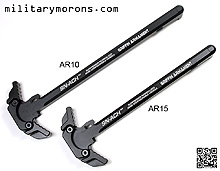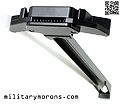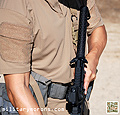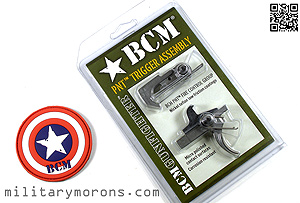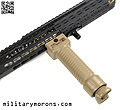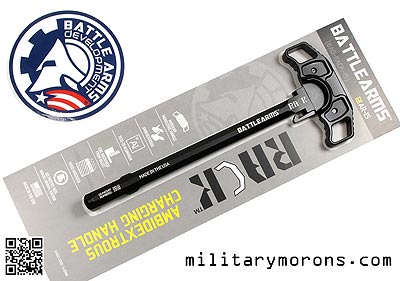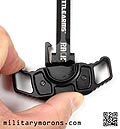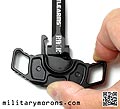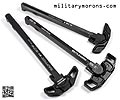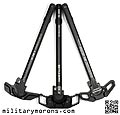AR15 Accessories Page 1 Page 2 Page 3 Page 4 Page 5 Page 6 Page 7
TO VIEW FULL SIZE IMAGES: USERNAME and PASSWORD are both "mm"
Griffin Armament SN-ACH Charging Handle
10/30/15 - The SN-ACH (Suppressor Normalized Ambi Configurable Handle) from Griffin Armament is an ambidextrous charging handle for the AR15 and AR10 with user-configurable levers and a gas vent that reduces gas in the face of the shooter when using a suppressor. Background - As a left-handed shooter, I've been delighted over the past few years to see the availability of ambidextrous controls for the AR15 steadily increase. While we still live in a right-handed world, there's no reason why our weapons have to. Ambidextrous controls are more the standard than the rarity on the newest weapons, and it's good to see the AR15 get an update. The offering of ambi controls for the AR15 have given the design greater longevity and relevance than ever before as it now caters to both left and right-handed shooters. For those who don't use suppressors, gas in the face isn't an issue. But for those who do, gas can be an issue, especially when the gas starts stinging the eyes. I've shot full auto SBR ARs with suppressors before, and got a nose-full of acrid gas with each burst, and stinging eyes. I'm a lefty, however, so I'm getting the full blast of any gas drifting back from the ejection port. Gas escapes out of the receiver any way that it can; above and below the charging handle, between the upper and lower etc. PRI came out with their 'gas buster' charging handle years ago, which features channels to divert gas out of the right side of the upper receiver. The Griffin SN-ACH takes these two ideas (ambi and gas diverting) and marries them into one product. Description - The SN-ACH is made of 7075-T6 aluminum and features a gas check groove and suppressor gas vent/port that is designed to reduce the amount of gas hitting the face of the shooter when using a suppressor. The hook that engages the bolt carrier features reinforced geometry for a 30% in strength over the milspec handle; there's a web that connects the shaft and the hook, similar to that on the PRI Gasbuster. The SN-ACH has configurable levers so that the user can choose to run the standard (long) levers, or purchase the shorter ones separately. I prefer to use a combination of the two - long lever on the right (I'm a lefty) and short one on the left; since I pull back the charging handle with my right hand. The handle and levers are hard coat anodized for optimal wear resistance. The back of the handle has a gas-check groove on the bottom, which is supposed to help reduce the gas blowing by on the bottom of the handle. Without an actual flexible seal, I'm not sure how effective it would really be. There are a couple of fitting pads on the top of the handle behind the hook, which help keep the charging from wobbling in the receiver. Two T10 torx screws serve as the lever pivots, and when removed, allow the levers to be swapped out, as well as the spring. The first run of SN-ACH handles had a spring that was too weak, and some customers had the latch hook 'jump the groove' on the receiver when shot. Griffin shipped out replacement springs which addressed the issue. All current production SN-ACHs have the stronger spring. Shown here are both versions of the SN-ACH, in an AR-15 and AR-10 (.308). One thing I did notice was that there was slight contact with the adjustment wheel on my Troy folding rear sight. Nothing that interfered with the function though. So, do keep that in mind when pairing the SN-ACH with your rear sight. I found that rear sights that don't hang below the level of the upper receiver flat top work best. Notes/Observations - The Griffin SN-ACH is well made; I noticed that the finish seemed a bit smoother than some other charging handles. This translates to nice and smooth operation in the receiver. I always oil the charging handle before installation as well, but some charging handles feel like they drag more. I like a combination of the long and short levers as I seldom use the lever on one side. I found swapping levers to be relatively easy. I was able to compress the spring and hold the lever in place with one hand while the other inserted the screw and tightened it. The latches feel comfortable and secure when using a pinch hold to draw the handle rearward; both with and without gloves. Since I don't currently have the opportunity to shoot suppressed, I didn't have the chance to see whether the gas-reduction features really work. Griffin estimated the effectiveness of the gas port to be around 40%. It doesn't eliminate gas in the face but does reduce it. A silicon seal would probably reduce it further but would add complexity/parts to the design. Plus, a silicon seal would be a wear item. Since the gas port vents gases out of the right side of the handle, it's not really designed for a lefty shooter like me (for use with a can, that is). So, I'm not sure I'd recommend it for a lefty shooter using a suppressor; just based on the design. If someone has experience with this and finds otherwise, contact me to let me know. As a regular ambi charging handle for left-handed, non-suppressed use, it works very well (or for right-handers of course, both suppressed and non-suppressed).
|
BCM PNT Trigger Assembly and Enhanced Lower Parts Kit
2/6/16 - Bravo Company USA has introduced the BCM PNT Trigger Assembly (Polished - Nickel - Teflon) and BCM Gunfighter Enhanced Lower Parts Kit. The Lower Parts Kit features the PNT Trigger Assembly along with all U.S.-made components. Background - An AR-15 LPK (Lower Parts Kit) contains all the necessary parts (fire control group, springs, pins etc) to complete a stripped lower receiver; except for the stock/receiver extension assembly. LPKs are available from a number of vendors and manufacturers; some with known pedigrees, and others with 'generic' parts of unknown origin or quality. BCM's parts are all made in the U.S. and the customer can be assured of quality components. I typically buy lower parts kits minus the trigger and hammer assemblies, grip and safety as I typically don't use the USGI versions of those components, but for the customer who prefers a better-than-'USGI' kit, the BCM Enhanced LPK is a good choice. PNT Trigger Assembly - The PNT Trigger Assembly consists of the BCM PNT hammer and trigger, hammer and trigger springs, the pivot pins, disconnector and disconnector spring. 'PNT' refers to Polished, Nickel and Teflon. The PNT trigger and hammer are machined from Mil-Spec AISI8620 investment castings per the USGI TDP. These are not to be confused with MIM parts commonly found in the commercial market. The .156/.157 holes are honed to assist in alignment and a smooth trigger pull. Both parts go through a 3-step heat treat and case hardening process for optimal grain structure alignment, for strength and wear resistance. Polished - The sear engagement surfaces are ground, then hand polished for increased smoothness and reduction in friction up to three times beyond the Mil-Spec. Nickel - This is what gives the parts their silver-grey finish. An electroless nickel finish is applied for a smoother trigger pull with reduced felt creep and grittiness. Nickel also provides a long lasting, corrosion and rust-resistant finish. Both the trigger and hammer have BCM's star logo on them for identification. Teflon - Teflon particles are embedded in the nickel, further reducing friction and ensuring a long-lasting coating. The hammer and trigger pins are centerless ground to a fine finish and toleranced to ensure compatibility with all Mil-Spec lower receivers. The BCM Disconnector is stamped from a 1070 material and fine blanked for cleaner edges, and double disc ground to precise size. Hammer engagement surfaces are ground for a clean reset. BCM Enhanced Lower Parts Kit
- The BCM Enhanced Lower Parts Kit includes the PNT trigger/hammer
assembly and all the other parts (excluding the receiver extension
and stock) necessary to complete a stripped lower receiver. LPKs
include your choice of BCMGunfighter
Grip Mod 3/trigger guard colour (Black, Flat dark earth, Foliage
green or Wolf gray).
Where applicable, parts are made from alloy steel put through a 3-step heat treat and case hardening process, and ground for precision. Takedown detents have a cadmium chromate coating to resist corrosion and prevent them from seizing in the small lower receiver holes. Springs are 17-7PH stainless steel. Notes/Observations - The PNT Trigger and Enhanced Lower Parts Kit offer high quality at a reasonable price. The PNT Trigger bridges the gap between a USGI trigger and a specialty after-market trigger like a Geissele. The PNT retains the reliability of a mil-spec set up while reducing the creep and grittiness present in the standard trigger setup. When I refer to 'USGI', I mean good-quality mil-spec parts; not the cheap commercial gun-show parts bin types. When new, good quality triggers from Colt and LMT for example, will still have noticeable creep until many rounds later when the mating surfaces have smoothed out somewhat. The PNT trigger assembly bypasses that 'break-in' period. I used my Lyman digital trigger pull gauge to take some measurements. For an LMT trigger assembly that I hadn't done anything on, I measured between 8lb 6.5 oz and 8 lbs 14 oz. For one that I had done a home trigger job on (polishing mating surfaces carefully), I measured a pretty consistent 6 lbs 13.5 oz. I installed the PNT trigger assembly into a lower and took multiple measurements on the PNT trigger (I used some grease on the hammer/trigger engagement surface as I normally do when assembling lowers) and readings ranged from 6 lbs 6oz to 6 lbs 12 oz; with most hovering around 6 lbs 10 oz. Creep was barely noticeable; I didn't feel any grittiness in the pull. It felt pretty smooth all the way through. Reset was also crisp without grit. I examined all the other small parts in the kit and they looked like good quality stuff, as I'd expect from BCM. I'd like to see an Enhanced kit packaged without the grip or trigger guard, as grip choice is personal and I don't use grips with a backstrap (short fingers). Many of the newer lowers have integral trigger guards as well. I always like to have a few LPK's around as spares; but they always seem to disappear into new lowers. I'm sure that BCM's offerings will be a very popular choice when it comes to buying LPKs to complete new lowers.
|
